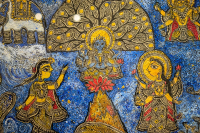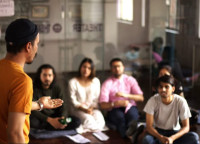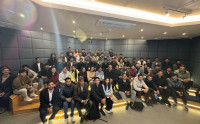Culture & Lifestyle
When it comes to portraying ethnicity, Nepali pop culture still depends on stereotypical tropes
From using blackface makeup to actors speaking in exaggerated indigenous accents, why is Nepali films and television still filled with regressive cultural stereotypes?
Ankit Khadgi
When Pallavi Payal saw a recent video that was circulating on social media of comedian Sandip Chhetri, she was furious. In the short video, Chhetri is seen impersonating a Madhesi woman, speaking in an exaggerated accent about the recently endorsed amendments regarding the Citizenship Bill, which many people, especially from the Madhesi community, have voiced concerns over.
In the video, he talks about how the amendments—if brought into effect—will prove to be detrimental to the interests of women, particularly Madhesi women. And while the issues he raises deserve public concern, his insensitive approach in depicting them led to a public uproar on social media in the past week.
“The Madhesi community is trying really hard to create awareness about how the citizenship bill could affect Madhesi women disproportionately. By making a mockery of the issue and the community that is already marginalised harms these efforts,” says Payal, an independent researcher and artist.
And this is not the first time Chhetri has been condemned for stereotyping Madhesi communities. In his show, ‘What the Flop’, which airs on Kantipur Television, he has played the role of Mithai Lal Yadav, a Madhesi person, by employing time-worn, discriminatory tropes, such as using black face paint. He later stopped using blackface makeup on the show after coming under fire for it. Another television show, ‘Corona Birsaune Gaphgaaph’ on Krishi Television, was also criticised for blackfacing a character.
For decades, regressive cultural tropes—such as using blackface, speaking in exaggerated indigenous accents and reducing characters to just their cultural identity for filler roles or comedy relief—have been used in Nepali pop culture. And although in recent years, concerns regarding the problematic stereotypical representation of ethnic minorities in mainstream Nepali media has come to the fore, such tropes continue to be used.
According to filmmaker and film educator Abimanyu Dixit, this is because such stereotyping is the foundation on which Nepali films were born. “If we trace the history of how films were introduced in our country, most of them were agenda-driven to please and push King Mahendra’s ‘one language and culture’ policies,” says Dixit, who’s also the Post’s film critic.
According to Dixit, the trope of ‘Arya Soundarya Chet’ has been significantly used to differentiate who can or cannot be a hero in Nepali pop culture. “There are preconceived features which people associate with heroes and how they should look like,” says Dixit. “For instance, a hero of a story should be tall, have broad shoulders and long, straight hair and a distinct facial structure, like a sharp nose. If a certain person ticks all of these features, then they are considered heroes, and if they don’t, they are considered as ‘others’ who are always shown as the villains,” says Dixit.
Going by this, Pahades, or the people who live on the hills of Nepal (particularly those belonging to the “higher caste” Brahmins and Chhetris), fit in the role of heroes, whereas other enthic minority groups, the Janajati communities, fit the role of the villains. And this trope has been regularly deployed by filmmakers in Nepal. “If we look back at old Nepali movies, they all show Janajati groups as aggressive people who are always the villains of the story,” says Daya Hang Rai, a popular actor.

Today, this trope has been slightly altered. Films these days show Janajatis as comedy sidekicks who support the Pahade heroes in their journeys. Actors like Buddhi Tamang, Jayananda Lama, Wilson Bikram Rai, Rear Rai are a few of the handful names who are regularly cast in big banner movies where their roles are limited to comedy roles without proper character development.
Because the Janajatis are now limited to comic characters, the role of menacing villains are now played by Madhesis, says Dixit. Films like the 2019 ‘Saruto’, ‘Shatru Gate’ (2018), ‘Sanrakshan’ (2017), ‘Bhairav’ (2015) have shown Madhesi characters as villains. Besides showing Madhesis as antagonists who are selfish, cunning and corrupt, films like ‘Bhairav’, ‘Saruto’ and ‘Sankrashan’ have also shown the Pahade protagonist to be a hyper-nationalist, who teaches the value of the “Nepali soil” and nationalism to Madhesi characters.
According to Kalpana Jha, researcher, and writer, this type of stereotypical representation is a byproduct of how cultural minority groups are viewed as by the dominant group whose mentality is informed by casteist, racist attributes.
“Such shows are definitely an attempt to demean and degrade certain communities. It’s not that they have no understanding of the diversity of the culture, but there is no intention to develop any understanding as such at all,” says Jha.
Asmita Shrish, an indigenous filmmaker, also believes that one of the reasons why stereotypes take place in the first place is because of a lack of respect and empathy towards indigenous groups. It also happens because of the lazy working culture among the filmmakers who jump into the bandwagon of simplifying the social world by reducing the amount of processing and thinking they have to do, she says.
“We haven’t yet acknowledged the terms ‘cultural sensitivity’ or ‘representation’. The diversity within various indigenous groups hasn’t been recognised yet by formula filmmaking,” says Shrish. But Shrish believes that the fault also lies among the audience who have been enjoying this stereotypical representation without asking any questions. “There is a consumption/demand for such films or songs or dances meaning the general public still enjoys the stereotypes, they are still not aware or educated. For me, that is the main problem,” she says.
And there is truth in her statement. Actors Sandip Chhetri, Deepak Raj Giri, Shiva Shankar Rijal, Sitaram Kandel have time and again portrayed stereotypical characters and the public has enjoyed their performances, leading them to travel and perform the same characters on the world stage.
Some of the actors who play these stereotypical roles do not see this stereotypical representation as a problem. “I am an artist and I should be able to play different roles. For representation’s sake, I can’t go looking for a terrorist because someone needs to play the role of a terrorist,” said Deepak Raj Giri to the Post last year, when he was asked about the use of blackface makeup.
Chhetri, however, apologised for his video, saying that his intention was not to hurt anyone. He repeatedly clarified that rather than humiliate anyone, he was trying to represent Madhesi communities. But few are convinced.
“If they were really concerned about representation they would hire Madhesi actors and write meaningful roles that will help to break stereotypes and improve social harmony,” says Payal. “Such programmes are basically cashing in on the existing problematic mindset but at the same time instead of changing it, they are making it stronger.”
But it isn’t that Nepali films and shows have not evolved at all. In recent years, there have been attempts by the film industry to become more inclusive and it has given opportunities to actors from indigenous communities as well. According to Dixit, Dipendra Lama, Rambabu Gurung, Deepak Rauniyar, Renasha Bantawa Rai are the handful of filmmakers who have somehow shown efforts to break away from writing such roles.
Likewise, actors like Daya Hang Rai, Najir Husen, Rabindra Jha and Ramesh Ranjan Jha have been getting more opportunities in the celluloid to showcase their acting caliber. But it comes with its own set of struggles. Most filmmakers end up boxing their talent by offering them similar roles that confine the characters to their cultural identities only.
“I was offered more than half a dozen roles within 15 days of the release of Hostel Returns to play the same kind of role: of a Madhesi student, speaking in an accent,” says Husen, who has had to face graver discrimination for coming from a Muslim minority group. “There were times when people used to question my nationality. My Instagram would be filled with messages from people who threatened me to leave the movie industry and stop playing movies with their ‘heroines’.”
Besides affecting the careers of these actors, such representation can add to already existing racism and bias against cultural minorities. “Harmful stereotypes create a limited idea of a group,” says Payal. “This trickles back down into society. For instance, after seeing how Madhesis are represented on TV and films, people will discriminate against them. And the cycle will continue. That is how a random stranger in a microbus has the audacity to tell me that my Nepali is really good for an ‘outsider’,” she says.
Seeing how powerful a medium television and films can be, a sensitive portrayal of indigenous, ethnic communities can be crucial in highlighting the problems of marginalised communities and also improve social harmony. “Pop-culture, if taken in the spirit of ‘culture of the people’, can certainly aid in the development of a broader understanding and empathy towards the marginalised communities,” says Jha, author of The Madhesh Upsurge and the Contest Idea of Nepal. But the representation has to be more nuanced, with well thought out portrayals of indigenous groups.
“We live in intentional oblivion. An inter community dialogue seems very urgent and an effort
towards understanding, empathising and learning about the minority and the marginalised and their way of life is becoming ever more urgent,” she says.




 5.55°C Kathmandu
5.55°C Kathmandu















